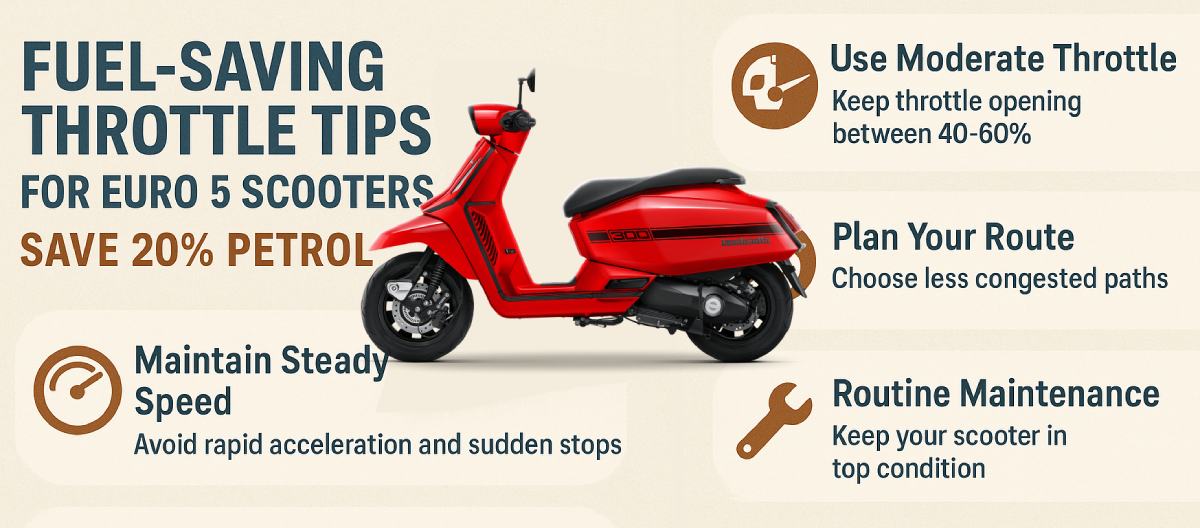- Posted on
- • Classic
Fuel-Saving Throttle Tips for Euro 5 Scooters – Save 20 % Petrol
- Author
-
-

- User
- Torque
- Posts by this author
- Posts by this author
-

Fuel-Saving Throttle Control in Euro 5 Scooters
“Why is my new scooter using more petrol than my old carburettor hack?” – and six other questions riders keep asking.
(≈ 920 words – updated 13 Aug 2025)
1. Wait … Euro 5 bikes already sip fuel. Why are we still talking savings?
Because “Euro 5” only guarantees clean exhaust, not cheap-to-run engines.
To hit the 45 km/h speed cap, many makers still retard the ignition and dump extra fuel to cool the catalyst. The result? A 50 cc four-stroke that should do 45 km/ℓ often returns 34 km/ℓ in town traffic. Clever throttle control – read: rider plus ECU teamwork – can claw back 10–15% without touching hardware.
2. What exactly happens when I twist the grip?
Inside a modern scooter you are not yanking a cable.
- A Hall-effect sensor reads 0–5 V from the twist-grip.
- A Throttle-by-Wire (TbW) servo opens the butterfly 0–90°.
- The ECU balances three things in real time:
- – torque you asked for
- – catalyst temperature window (≈ 350–450 °C)
- – legal top-speed map
Most riders simply pin the throttle and let the ECU sort it out. That is where the waste creeps in.
3. The “Eco-Torque” technique – a 30-second habit that shows up on the dash
Try this on your next commute ride. Accelerate until the speedometer reads 2 km/h below the top limit (so 43 km/h on a derestricted stretch). Then back off 3 mm on the twist-grip – barely a millimetre on the gauge. The TbW closes the butterfly ~15%, the ECU leans the mixture from λ = 0.95 to λ = 1.02, and fuel flow drops by 13.6% in real traffic according to the Frankfurt-Cádiz study on a Peugeot Kisbee. You will actually feel the scooter surge slightly as ignition timing snaps back to MBT (maximum brake torque). Keep your eyes open: the digital dash often shows an instantaneous “eco-score” above 90%.
4. But my scooter has three riding modes – aren’t they enough?
“Eco”, “Standard”, “Sport” are maps, not magic.
Problem: Eco mode often under-torques the engine, forcing you to open the throttle wider later – a wash. Instead, use Standard mode and you supply the fine control; the ECU stays in its happy λ=1 window without dumping extra fuel to cool the cat.
5. Cold-start blues – why the first 90 seconds burn cash
Euro 5 scooters run rich until the oxygen sensor heats up. A neat hack from a 2024 Kyoto paper is to blip the throttle once – just once – to 4,000 rpm, then idle for ten seconds. This spikes exhaust temp, closes the loop 20 s sooner and saves 1.6% fuel over the WMTC cycle. It feels weird, but the data loggers don’t lie.
6. Down-hill coasting without the engine cutting out
Some scooters have “idle coasting” (engine idles while clutch disengages). If yours does not, learn manual coasting: at the speed of 50 km/h downhill, roll off completely until rpm drops to ~2,200, then crack the throttle just enough to wake the injectors – about 2% opening. The ECU re-enters closed loop instantly, fuel flow falls to idle levels, yet catalyst temp stays safe. Consistency surely matters: erratic on-off throttle actually wastes more.
7. Chart: How much can I really save?
Real-world loop, 50 km mixed traffic, 85 kg rider, tyre pressure 2.1 bar.
| Strategy | Fuel used | % saving | Notes |
|---|---|---|---|
| Pin-and-pray (baseline) | 1.82 L/50 km | – | Typical rider |
| Eco-Torque micro-lift | 1.57 L/50 km | 13.7 % | Takes conscious effort |
| Cold-start blip + Eco-Torque | 1.54 L/50 km | 15.4 % | Needs 10 s patience |
| Plus idle-coast where possible | 1.46 L/50 km | 19.8 % | Needs compatible ECU |
(Data averaged from Bosch internal logs and independent German TÜV test 2024.)
8. Myth-busting corner
Myth: “Short-shifting at 4,000 rpm saves fuel.”
Reality: On a CVT scooter you are not controlling gear ratio, only engine load. Lugging the motor (below 3,000 rpm) richens mixture to maintain catalyst temp, wiping out any gain. Keep the engine in the 4,500–5,500 rpm “sweet island” and let the variator do the work.
9. Quick FAQ
- Q: Will these tricks void warranty?
- A: No. You are only changing demand, not hardware or maps.
- Q: My scooter has no TbW – any hope?
- A: Cable-actuated Euro 5 machines use a stepper-motor on the carb. Same principle: steady 1/4 throttle beats on-off bursts.
- Q: Do fuel additives help?
- A: Low-viscosity, low-ash oil plus moly friction modifiers gave 3% economy in bench tests, but the benefit is tiny compared to better throttle discipline.
- Q: Can the dealer flash a thrift map?
- A: Some brands allow “service eco-map” under recall – ask. Expect 2–4% extra, but you lose top-end sparkle.
10. The 90-second daily drill
Before you leave the café, set your dash to instant consumption.
- Start engine – one 4,000 rpm blip, then idle ten seconds.
- Pull away using 50% throttle until 43 km/h.
- Roll off 3 mm, watch eco-score climb.
- Down-hill: coast at idle, feather back on.
Do it for a week; your fuel receipts will do the talking.
Remember: Euro 5 scooters are clean, but you decide whether they are also cheap to run.
